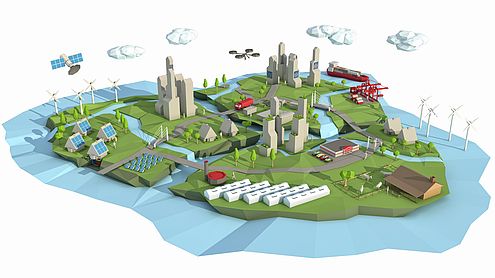The New Delta
The Delta Works that made the Netherlands famous, especially the works in the delta regions of the Rhine, Meuse and Scheldt, were completed in the late 1980s. The following core strategies were implemented in actual physical works: coastline shortening, compartmentalisation - for the purpose of improving safety - improved access to the Holland and Zeeland islands, and freshwater supplies. The coastline shortening was made adjustable through the closable Oosterscheldekering, the closable Haringvliet sluices and the Maeslantkering. As a result of the Zuiderzee works and the Delta Works, a situation has arisen in the Netherlands in which there is a close connection between the water resource management system, the economic system and spatial planning. This cohesion was mainly formed in the decades after the Second World War. It created a synergy that led to added value, both for each individual sector and for them together as a whole. This synergy was created in a political climate that was strongly top-down and focused on the development of a welfare state based on an industrial economy.
Currently, however, the Dutch delta is experiencing a fundamental transition, in which the conditions of all individual domains have changed significantly and it is unclear whether a new connection can be created that once again has added value for the components and the whole, and if so, what type of connection that will be.
So far, there is still no clear picture of the state of affairs of the 'new Delta Works' and how they could be combined with and contribute to new economic and spatial developments. Now that the new Delta Programme is being converted from policy to development and implementation, it would be interesting to chart the initial results achieved and to evaluate their role in meeting the new objectives of the Delta Works 2.0, and to see what has been achieved, what will follow in the short term and what has been envisioned for the long term. In other words: what is the state of affairs with regard to the realisation of the delta of the future?

This evaluation is important for both internal and external use.
'Internally', this evaluation is important due to the fact that the training of future generations of engineers and other professionals, the current practice, which is focused on the DUTCH approach, and the new implementation would benefit from it. In addition, the evaluation also provides the foundation for determining which type of research is needed to make progress.
'Externally', this evaluation is an important means of informing the outside world about the changes being made to the delta system. Foreign visitors too often regard the Delta Works of 50 years ago as the most up-to-date example of the Dutch approach; the planned evaluation will provide an overview of the Delta Works 2.0.
The evaluation therefore proceeds from the objectives of the Delta Memorandum and the LT Development Outline for the Scheldt estuary. The evaluation identifies which projects have been implemented, which projects are being prepared and which initiatives are planned for the long term. It also examines the consequences of the projects, as well as their opportunities for governance, spatial development and economic development. The evaluation ends with a commentary on the desired approach for the follow-up
